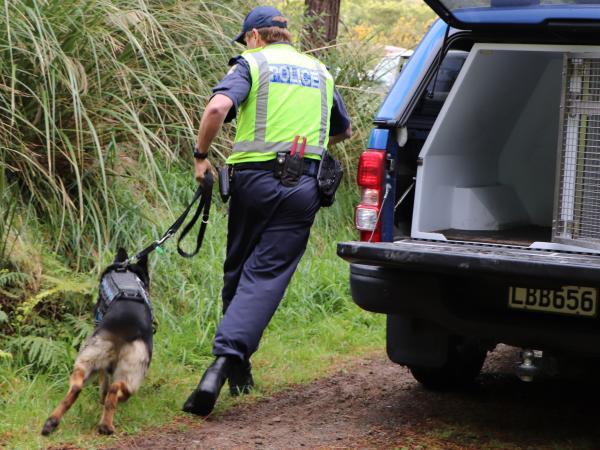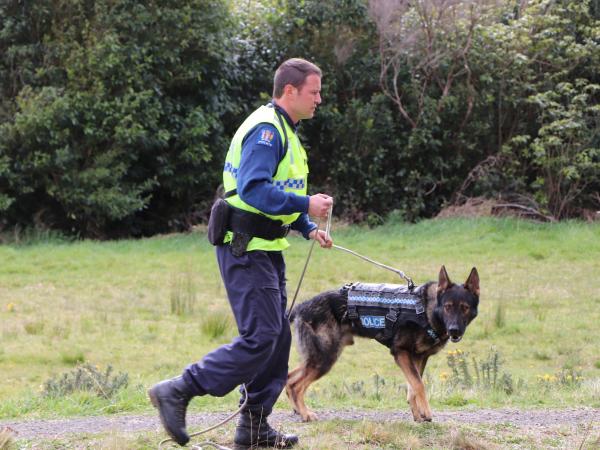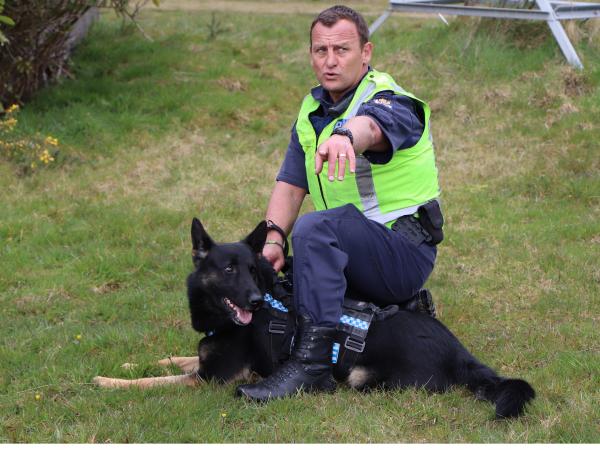Up hill, down dale, in and out of houses – it might sound like something out of a nursery rhyme, but for those involved in the nationals it’s anything but child’s play.
Before the prizegiving for the National Police Dog and Detector Dog Championship last week came three days of intensive, hard work for the 12 patrol dog, six narcotics detector dog and five explosives detector dog teams who qualified to compete.
The nationals put the teams to the test away from the public gaze in remote areas of the Hutt Valley and Wairarapa.
Inspector Todd Southall, National Coordinator Police Dogs, says what the judges are looking for is simple – perfection.
Eventual champion patrol dog team Senior Constable
Mark Chapman and Mario.
“The trials are a test of what they do in the operational environment,” he says. “There are no tricks. What we ask is for them to do what they do every day, to a very high standard of execution.”
The teams start off with 1300 marks and lose some each time something could have been done better – when a command had to be repeated, for example.
The highest-scoring tests are the ‘bread and butter’ tasks of their work. For patrol dog teams these are tracking, searching buildings for people and apprehending offenders.
For detector dog teams, it is their systematic search patterns and the dogs’ odour recognition – their ability to sniff out firearms, cash, narcotics or explosives.
Other tests include obedience to a variety of commands, heelwork and a formal retrieve, which ends with the dog giving the retrieved item to the handler and sitting quietly in front of them.
“For all of them it’s about making sure they’re able to work in a range of operational environments,” says Todd.
“In the incident we staged for the patrol dogs there was a lawnmower, music playing, and a TV cameraman they had to deal with. For the detector dogs it’s about being able to work in all environments, searching vehicles, people, houses.
“You can never exactly replicate a real-life scenario. What we find when we plan a scenario is that there are 1000 different ways to approach it. No two handlers would approach it in the same way. That’s the reality of frontline policing.”
Role-players from the agencies involved – Police, Customs, Corrections, Aviation Security and the Army – provided a degree of realism throughout the competition.
The ‘offenders’ arrested by each of the patrol dog teams were dog section volunteers Sergeant Bill Birrell (Hawke’s Bay) and Constable Cam Mullenger (Wellington). One distraction was provided by Constable Dan Waluszewski (Hutt Valley), who was noisily and chattily mowing ‘his’ lawn as the scenario unfolded. (continues below)
Police Public Affairs provided two volunteers to help test the patrol dog team - the ‘TV cameraman’ was Social Media manager Simon Flanagan, and Reality TV coordinator Kaye Calder kept popping up as a pesky photographer.
Simon’s video camera was really rolling – you can see the result here - and Kaye captured the stills which accompany this story, giving us this rare glimpse behind the scenes of a competition usually witnessed only by a very few.













